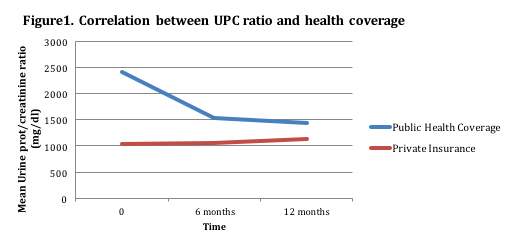Session Information
Date: Tuesday, October 23, 2018
Title: Epidemiology and Public Health Poster III: SLE, SSc, APS, PsA, and Other Rheumatic Diseases
Session Type: ACR Poster Session C
Session Time: 9:00AM-11:00AM
Background/Purpose:
Despite therapeutic advancements, lupus nephritis (LN) remains a major cause of mortality among patients with SLE. Loma Linda University Health serves a region in Southern California represented by more individuals below the federal poverty line than the rest of California. As prior studies have demonstrated the impact of socioeconomic status (SES) on long-term outcomes in SLE in their respective counties, we studied the correlation between SES and LN prevalence in our cohort. We further investigated the association between SES, SLE disease activity, and treatment response in a subgroup of LN patients.
Methods:
Adult subjects were recruited from the Southern California Lupus Registry (SCOLR). Sociodemographic data, urine protein to creatinine ratio (UPC), SLEDAI at baseline and 6 months, and insurance type were collected. Using insurance as a surrogate for SES, subjects were divided into 2 groups, public versus private insurance. The prevalence of lupus nephritis was then identified and differences in clinical variables and treatment response in the subgroup were assessed using t-test and chi-square analyses.
Results:
162 SLE patients were recruited. 33% were Caucasian, 36% Hispanic, 11% Asian, and 20% African-American. 42% of patients had public health coverage. After adjusting for age, sex and BMI, SES was independently associated with the prevalence of nephritis (P = 0.038) (Table 1).
A subgroup analysis of LN patients demonstrated baseline statistically significant higher UPC in patients with public compared to private insurance (P= 0.053) (Figure 1); a similar trend was noted at 6 months. Baseline and 6 month SLEDAI also demonstrated higher numbers among patients with public compared to private insurance (14.91 vs. 11.31; 13.30 vs. 10.42 respectively). No association was detected between medications and insurance type.
Conclusion:
SES is associated with greater morbidity in SLE and is a key target for improving outcomes. To our knowledge, this is the first study comparing differences in treatment response to SES in SLE and LN patients in Southern California. In line with prior reports, our findings confirm the association of health insurance with long-term outcomes in SLE and LN. These findings warrant further studies to advocate for change in the health care industry to improve long-term outcomes in SLE.
|
Table 1. Multivariable Analyses Against Prevalence of Lupus Nephritis
|
||
|
|
Odds Ratio |
P-Value |
|
Age |
0.982 (0.955 – 1.009) |
0.195 |
|
Female |
0.993 (0.205 – 4.803) |
0.993 |
|
BMI |
0.968 (0.920 – 1.017) |
0.197 |
|
Public Health Coverage |
2.368 (1.052 – 5.330) |
0.038* |
To cite this abstract in AMA style:
Haghshenas A, Teh P, Choi K, Benitez A, Salto L, Firek M, Torralba K, Sandhu VK. The Effect of Socioeconomic Status on Treatment Outcomes in Lupus Nephritis: Private Versus Public Insurance [abstract]. Arthritis Rheumatol. 2018; 70 (suppl 9). https://acrabstracts.org/abstract/the-effect-of-socioeconomic-status-on-treatment-outcomes-in-lupus-nephritis-private-versus-public-insurance/. Accessed .« Back to 2018 ACR/ARHP Annual Meeting
ACR Meeting Abstracts - https://acrabstracts.org/abstract/the-effect-of-socioeconomic-status-on-treatment-outcomes-in-lupus-nephritis-private-versus-public-insurance/

